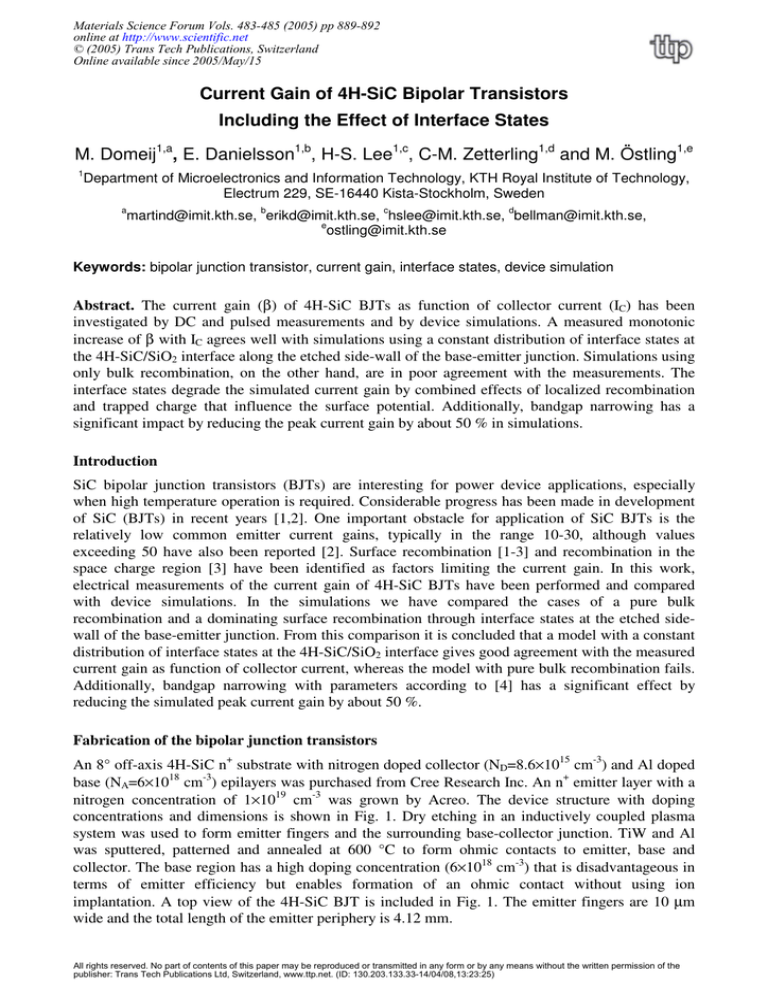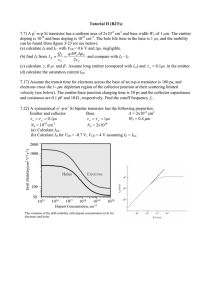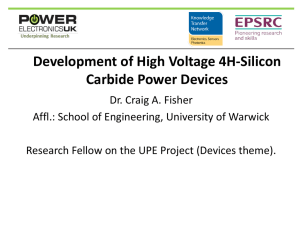
Materials Science Forum Vols. 483-485 (2005) pp 889-892
online at http://www.scientific.net
© (2005) Trans Tech Publications, Switzerland
Online available since 2005/May/15
Current Gain of 4H-SiC Bipolar Transistors
Including the Effect of Interface States
M. Domeij1,a, E. Danielsson1,b, H-S. Lee1,c, C-M. Zetterling1,d and M. Östling1,e
1
Department of Microelectronics and Information Technology, KTH Royal Institute of Technology,
Electrum 229, SE-16440 Kista-Stockholm, Sweden
a
b
c
d
martind@imit.kth.se, erikd@imit.kth.se, hslee@imit.kth.se, bellman@imit.kth.se,
e
ostling@imit.kth.se
Keywords: bipolar junction transistor, current gain, interface states, device simulation
Abstract. The current gain (β) of 4H-SiC BJTs as function of collector current (IC) has been
investigated by DC and pulsed measurements and by device simulations. A measured monotonic
increase of β with IC agrees well with simulations using a constant distribution of interface states at
the 4H-SiC/SiO2 interface along the etched side-wall of the base-emitter junction. Simulations using
only bulk recombination, on the other hand, are in poor agreement with the measurements. The
interface states degrade the simulated current gain by combined effects of localized recombination
and trapped charge that influence the surface potential. Additionally, bandgap narrowing has a
significant impact by reducing the peak current gain by about 50 % in simulations.
Introduction
SiC bipolar junction transistors (BJTs) are interesting for power device applications, especially
when high temperature operation is required. Considerable progress has been made in development
of SiC (BJTs) in recent years [1,2]. One important obstacle for application of SiC BJTs is the
relatively low common emitter current gains, typically in the range 10-30, although values
exceeding 50 have also been reported [2]. Surface recombination [1-3] and recombination in the
space charge region [3] have been identified as factors limiting the current gain. In this work,
electrical measurements of the current gain of 4H-SiC BJTs have been performed and compared
with device simulations. In the simulations we have compared the cases of a pure bulk
recombination and a dominating surface recombination through interface states at the etched sidewall of the base-emitter junction. From this comparison it is concluded that a model with a constant
distribution of interface states at the 4H-SiC/SiO2 interface gives good agreement with the measured
current gain as function of collector current, whereas the model with pure bulk recombination fails.
Additionally, bandgap narrowing with parameters according to [4] has a significant effect by
reducing the simulated peak current gain by about 50 %.
Fabrication of the bipolar junction transistors
An 8° off-axis 4H-SiC n+ substrate with nitrogen doped collector (ND=8.6×1015 cm-3) and Al doped
base (NA=6×1018 cm-3) epilayers was purchased from Cree Research Inc. An n+ emitter layer with a
nitrogen concentration of 1×1019 cm-3 was grown by Acreo. The device structure with doping
concentrations and dimensions is shown in Fig. 1. Dry etching in an inductively coupled plasma
system was used to form emitter fingers and the surrounding base-collector junction. TiW and Al
was sputtered, patterned and annealed at 600 °C to form ohmic contacts to emitter, base and
collector. The base region has a high doping concentration (6×1018 cm-3) that is disadvantageous in
terms of emitter efficiency but enables formation of an ohmic contact without using ion
implantation. A top view of the 4H-SiC BJT is included in Fig. 1. The emitter fingers are 10 µm
wide and the total length of the emitter periphery is 4.12 mm.
All rights reserved. No part of contents of this paper may be reproduced or transmitted in any form or by any means without the written permission of the
publisher: Trans Tech Publications Ltd, Switzerland, www.ttp.net. (ID: 130.203.133.33-14/04/08,13:23:25)
890
Silicon Carbide and Related Materials 2004
3 µm
2 µm
400 nm
emitter
ND=1*1019 cm-3
500 nm
NA=6*1018 cm-3
10 µm
ND=8.6*1015 cm-3
N+ substrate
2 µm
3 µm
Interface states
SiO2
base
emitter
base
collector
Fig. 1 Schematic cross-section of half-cell (left) and top view (right) of the studied 4H-SiC BJT
Simulation models for the BJT
Device simulations were performed using the commercial software AVANT MediciTM. Physical
models were used for doping, temperature and electric field dependent mobility, SRH and Auger
recombination, Fermi-Dirac statistics and bandgap narrowing with parameters from [4]. Carrier
mobility parameters from Schaffer [5] were used with a correction according to [6] for the minority
carrier mobility in the case of incomplete ionization of dopants. TLM test structures on top of the
emitter epilayer were used to measure ρ=8×10-3 Ωcm in agreement with a fully ionized dopant
concentration of 1×1019 cm-3 according to the Schaffer model [5]. Complete ionization of
n=ND=1×1019 cm-3 (assumed above the Mott limit) was therefore used in the emitter whereas FermiDirac statistics for incomplete ionization of dopants was used in the base with the ionization energy
EA=0.18 eV for Al. Two different cases were compared for the recombination:
A) Pure bulk recombination with a carrier lifetime of τn=τp=1.2 ns and no interface states
B) Recombination and trapping in interface states at the etched side-wall along the base-emitter
junction (see Fig. 1) and a relatively high bulk carrier lifetime of τn=τp= 100 ns
Model for the interface states (case B).
SiC BJTs, have a SiC/SiO2 interface at the base-emitter sidewall where there is either a native oxide
or a thermally grown passivation oxide. To obtain a simple but realistic model for the interface state
density, a constant density of interface states DIT=7.5×1011 cm-2eV-1 was assumed over the whole
bandgap at the interface between 4H-SiC and SiO2 (see Fig. 1). The DIT value is of the same order
of magnitude as reported values for MOS structures on the 4H-SiC 0001 interface [7]. The traps in
the lower half of the bandgap are donors and acceptors are assumed in the upper half. A thermal
velocity of 2×107 cm/s and a capture cross-section of σ=6×10-15 cm2 were used. It should be pointed
out that there could be defects also at the base-emitter epi-interface (due to the interrupted epitaxial
growth) but this has not been taken into account and it is therefore an uncertainty in the analysis.
Experimental technique
Measurements of base current IB and collector current IC at constant collector-emitter voltage VCE
were performed both under DC and pulsed conditions to determine the common emitter current gain
β over a wide variation of IC. The DC measurements were performed using a probe station equipped
with a HP4156A parameter analyzer. The pulsed measurements were conducted using a digital
oscilloscope equipped with PearsonTM current transformers. β was extracted in a quasi-steady state
300 ns after turn-on of the base current to minimize effects of heating. The base-emitter voltage was
kept below the constant VCE=17 V to ensure that the transistor remained in its active region.
Materials Science Forum Vols. 483-485
891
Common emitter current gain
12
10
DC measurement
Pulsed measurement
Bulk recombination (A)
Interface states (B)
Fig. 2 Common emitter current
gain vs. collector current with
VCE=17 V: DC (filled squares)
and pulsed (open squares)
measurements. Simulations using
a high bulk recombination rate
with τn=τp= 1.2 ns (A – dashed
line), and with interface states at
the SiC/SiO2 interface with
DIT=7.5×1011 cm-2eV-1, σ=6×10-15
cm2 and a low bulk recombination
rate τn=τp=100 ns (B – solid line).
8
6
4
2
0
-5
10
0.0001
0.001
0.01
0.1
1
Collector current (A/mm)
20
Common emitter current gain
Interface states (B)
no bandgap narrowing (C)
Fig. 3 Simulated common emitter
current gain vs. collector current
with VCE=17 V. Interface states as
Fig. 2 (B – solid), parameters as B
but without bandgap narrowing
(C – dashed line),
parameters as B but with
negligible charge trapping
DIT=7.5×106 cm-2eV-1, σ=6×10-10
cm2 (D – dashed with squares).
15
no trapped charge (D)
10
5
0
-5
10
0.0001
0.001
0.01
0.1
1
Collector current (A/mm)
Results
Fig. 2 displays measured and simulated β over more than four decades of IC for a typical BJT. IC is
plotted in A/mm length of the cross-section shown in Fig. 1. The high base doping of about 6×1018
cm-3 is one important reason for the relatively low β. The monotonous increase of β with IC was
seen for all measured BJTs with about 20 % variation in the peak value of β. This increase can be
explained by a high recombination current in the base-emitter space charge region, since the
recombination current has a exp(qVBE/2kT) dependence while the diffusion current increases with
exp(qVBE/kT) (VBE being the voltage drop over the base-emitter junction). The simulation with bulk
recombination (B) fails to reproduce the measured increase of β with IC. This is because the
recombination current in the space charge region for τn=τp=1.2 ns is not sufficiently high and a
892
Silicon Carbide and Related Materials 2004
reduction of τn=τp affects the level but has only a slight influence on the shape of the β vs. Ic curve.
The interface states (curve B), on the other hand, cause a very high recombination current in the
space charge region, locally at the surface, and a better agreement is obtained with the measured β
vs. IC. The reason for the simulated negative β vs. IC slope at high currents is that high injection
occurs in the base close to the etched side-wall and this reduces the emitter injection efficiency. The
peak of curve B is at 50 % higher collector current than that of curve A since localized
recombination in the interface states suppress the onset of local high-level injection.
A comparison of different simulation models in Fig. 3 illustrates that bandgap narrowing (BGN)
with parameters from ref. [4] has a significant influence, i.e. the maximum current gain increases by
96 % if BGN is neglected. Additionally, the BGN model affects the position of the peak current
gain (see Fig. 3) and a discrepancy in the BGN model parameters is therefore a possible explanation
why the simulations in Fig. 2 show a negative β vs. IC slope while the measured β increases with IC
over the whole interval. In Fig. 3 a simulation is included with the identical product of DIT and σ as
curve B (the same effective carrier lifetime) but with a low value of DIT that results in negligible
trapped charge. The different β vs. IC behavior of curves B and D indicates that the effect of the
interface states is not a pure recombination effect but also an effect of trapped charge that influence
the electrostatic potential. Simulations indicate that the traps locally reduce the effective emitter and
base doping levels thus reducing the potential barrier and increasing the current locally in the
surface region. The simulated current gain degradation due to combined effects of recombination
and trapped charge in interface states is in qualitative agreement with simulations performed for
AlGaAs/GaAs HBTs including interface states in ref. [8]. For improvement of the current gain of
4H-SiC BJTs it is proposed to investigate if recent progress in SiC MOS technology such as NO
annealing can be used for improved passivation to reduce the interface state density.
Summary
The experimentally observed common emitter current gain vs. collector current for 4H-SiC BJTs
has been accurately modeled by device simulations using a constant distribution of interface states
at the 4H-SiC/SiO2 interface at the base-emitter junction. The simulated current gain reduction is a
combined effect of recombination and trapped charge. Additionally, bandgap narrowing has a
significant impact by reducing the peak current gain by about 50 % in simulations.
Acknowledgement
The authors are grateful to Acreo for epitaxial growth of the n+ emitter. The Swedish Energy
Agency is acknowledged for financial support.
References
[1] S-H. Ryu, A. K. Agarwal, R. Singh and J. W. Palmour, IEEE Electron Device Letters, Vol. 22
(2001), p 124
[2] C-F. Huang and J. A. Cooper, IEEE Electron Device Letters, Vol. 24 (2003), p 396
[3] P. A. Ivanov et al., Mater. Sci. Forum Vols. 457-460 (2004), p 1145
[4] U. Lindefelt, Journal of Applied Physics, Vol. 84 (1998), p 2628
[5] W. J. Schaffer et. al, Mat. Res. Soc. Symp. Proc. Vol. 339 (1994), p 595
[6] E. Danielsson et. al, Mater. Sci. Forum Vols. 457-460 (2004), p 1117
[7] V.V. Afanas’ev et. al, Mater. Sci. Forum Vols. 389-393 (2002), p 961
[8] C-W. Kim, N. Goto and K. Honjo, Solid-State Electronics, Vol. 38 (1995), p 633






